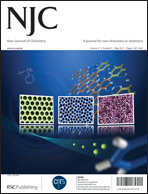A molecular analysis of the toxicity of alkyltributylphosphonium chlorides in Aspergillus nidulans†
Abstract
Investigating ionic liquids in vivo effects at a molecular level is crucial for the deeper understanding of their toxicity and the development of new biological applications. In the present study, we propose the use of qRT-PCR to analyse the expression of Aspergillus nidulans genes after exposure to alkyltributylphosphonium chlorides ([P4 4 4 n]Cl, where n = 1, 4, 8 or 12). The selected genes are involved in plasma membrane and cell wall biosynthesis and repair mechanisms. The data strongly indicate cell wall damage as the common mechanism of toxicity amongst these ionic liquids, while plasma membrane permeabilisation is dependent on the alkyl substituent length. Considering their effects on the fungal cell walls, the knowledge herein produced opens doors for several possible applications of quaternary phosphonium ionic liquids, in particular their potential use in antifungal formulations.


 Please wait while we load your content...
Please wait while we load your content...